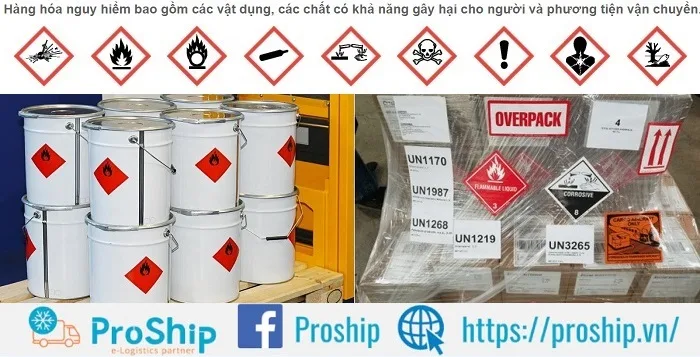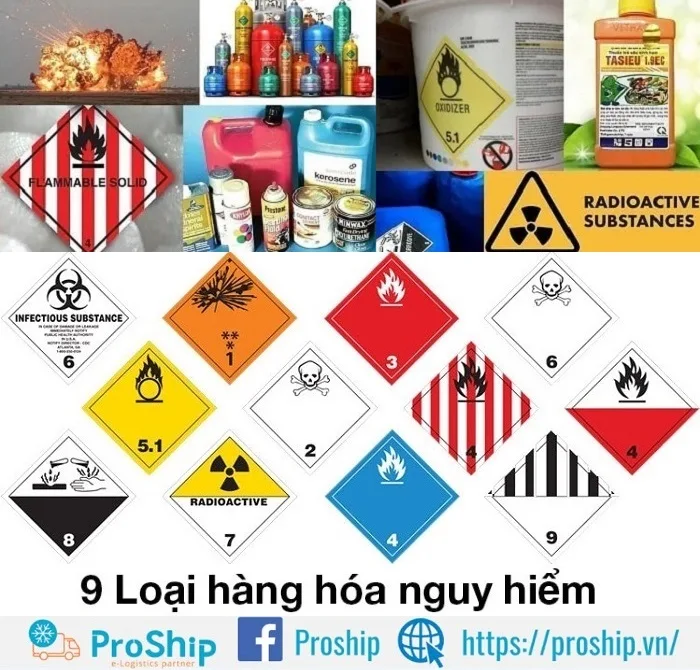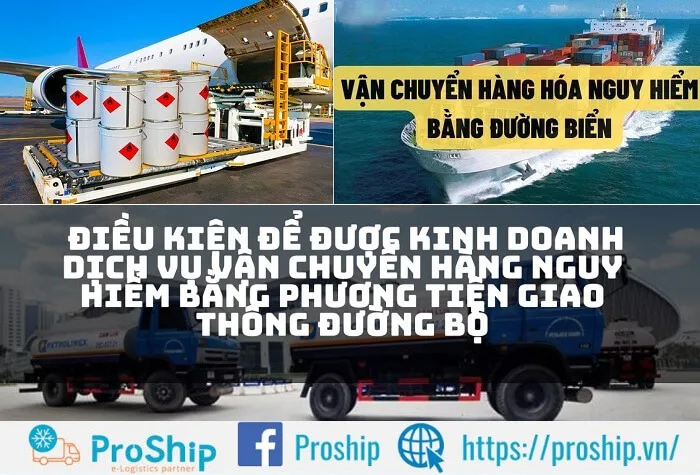x Bạn thắc mắc hàng nguy hiểm là hàng gì mà nhu cầu vận chuyển đi Bắc Nam ngày càng nhiều?
x Bạn cần biết hàng hóa nguy hiểm bao gồm những mặt hàng, nhóm hàng, loại hàng nào?
x Bạn muốn biết hàng nguy hiểm cần lưu ý gì và phải đáp ứng điều kiện gì để đảm bảo an toàn trong khi vận chuyển?
Proship.vn sẽ chỉ ra 9 nhóm hàng nguy hiểm, bao gồm chất lỏng, chất rắn, chất khí, chất phóng xạ, chất ăn mòn,…Một khi đã nắm rõ danh mục hàng hóa nguy hiểm thì các Cá nhân, Doanh nghiệp, Tổ chức sẽ có được phương án đảm bảo tốt nhất. Bên cạnh đó, khi chuyển mặt hàng này, việc chọn phương tiện vận chuyển an toàn, đúng chuẩn cũng góp phần đẩy nhanh thời gian giao hàng và hạn chế các sự cố có thể xảy ra trên đường.
📦 Hotline Liên Hệ Vận Chuyển
🧭 Miền Trung
Hàng nguy hiểm: Khái niệm và yêu cầu với phương tiện chuyển hàng
Thế nào là hàng nguy hiểm?
Trong lĩnh vực vận tải, hàng nguy hiểm là khái niệm không còn xa lạ. Và đây là một trong những yếu tố quan trọng cần được quan tâm trong quá trình vận chuyển, lưu trữ và sử dụng hàng hóa. Hàng hóa nguy hiểm (Dangerous Goods – viết tắt là DG) là mặt hàng chứa các chất độc hại gây ảnh hưởng đến sức khỏe, tính mạng con người, gây ô nhiễm môi trường, gây mất trật tự an toàn, an ninh quốc gia và gây nguy hiểm cho giao thông trong quá trình vận chuyển. Khi vận chuyển hàng nguy hiểm đường hàng không, đường thủy hay đường bộ đều phải chấp hành những quy định của Việt Nam cũng như Quốc tế.

Yêu cầu với phương tiện chuyển hàng nguy hiểm
Tại Điều 13 Nghị định 42/2020/NĐ-CP quy định về yêu cầu đối với phương tiện vận chuyển hàng nguy hiểm như sau:
1. Phương tiện vận tải hàng nguy hiểm PHẢI DÁN BIỂU TRƯNG hàng hóa nguy hiểm. Nếu trên một phương tiện có nhiều loại hàng hóa nguy hiểm khác nhau thì phương tiện phải dán đủ biểu trưng của các loại hàng hóa đó. Vị trí dán biểu trưng ở hai bên của phương tiện;
2. Phương tiện vận chuyển phải ĐỦ ĐIỀU KIỆN tham gia giao thông theo quy định của pháp luật;
3. Sau khi dỡ hết hàng hóa nguy hiểm, phương tiện vận tải hàng hóa nguy hiểm nếu không tiếp tục vận tải loại hàng hóa đó thì phải được làm sạch và bóc hoặc xóa biểu trưng nguy hiểm trên phương tiện vận chuyển hàng hoá nguy hiểm. Việc làm sạch và bóc hoặc xóa biểu trưng nguy hiểm trên phương tiện được thực hiện theo quy trình và ở nơi quy định.
Danh sách 9 nhóm hàng hóa nguy hiểm trong vận tải hàng cần biết
Danh mục hàng hóa nguy hiểm trong vận chuyển được Proship Logistics cập nhật và chia sẻ ngay sau đây. Theo Nghị định, tùy tính chất hóa, lý, hàng hóa nguy hiểm được phân thành 9 nhóm hàng nguy hiểm. Cụ thể đó là:
Nhóm 1: Chất nổ và vật phẩm dễ nổ
Bao gồm các loại chất và vật liệu có khả năng phát nổ. Ví dụ như pháo hoa, pháo sáng,…Tùy theo mức độ phản ứng, chất nổ được chia thành 6 nhóm nhỏ:
- Nhóm (Division) 1.1. Chất và vật phẩm có nguy cơ nổ rộng;
- Nhóm (Division) 1.2. Chất và vật phẩm có nguy cơ bắn tóe nhưng không nổ rộng;
- Nhóm (Division) 1.3. Chất và vật phẩm có nguy cơ cháy và nguy cơ nổ nhỏ hoặc bắn tóe nhỏ hoặc cả hai, nhưng không nổ rộng;
- Nhóm (Division) 1.4. Chất và vật phẩm có nguy cơ đáng kể;
- Nhóm (Division) 1.5. Chất rất không nhạy nhưng có nguy cơ nổ rộng;
- Nhóm (Division) 1.6. Vật phẩm đặc biệt không nhạy, không có nguy cơ nổ rộng.
Nhóm 2: Chất khí
Bao gồm các chất khí nén, hoá lỏng hay hoà tan có áp suất. Ví dụ bình ga, bình chữa cháy,…Có thể chia thành các nhóm:
- Nhóm (Division) 2.1 Khí dễ cháy;
- Nhóm (Division) 2.2 Khí không dễ cháy, không độc hại;
- Nhóm (Division) 2.3 Khí độc hại.
Nhóm 3: Chất lỏng dễ cháy và chất nổ lỏng khử nhạy
Ví dụ như các loại sơn, dầu, xăng, cồn,…
Nhóm 4: Chất đặc dễ cháy, nổ đặc khử nhậy, chất tự phản ứng, tự bốc cháy và các chất gặp nước sản sinh khí ga dễ cháy
Là các chất dễ bắt lửa hoặc có khả năng tự bùng cháy; các chất khi tiếp xúc với nước, tỏa ra khí dễ cháy. Ví dụ như photpho, lưu huỳnh, diêm,…Có 3 phân nhóm đối với hàng nguy hiểm loại 4 như:
- Nhóm (Division) 4.1: Chất rắn dễ cháy, chất tự phản ứng và chất nổ rắn được ngâm trong chất lỏng hoặc bị khử nhạy;
- Nhóm (Division) 4.2: Chất có khả năng tự bốc cháy;
- Nhóm (Division) 4.3: Chất khi tiếp xúc với nước tạo ra khí dễ cháy.
Nhóm 5: Hợp chất oxit hữu cơ và oxi hóa
Được chia làm 2 nhóm:
- Nhóm (Division) 5.1 Chất oxy hóa;
- Nhóm (Division) 5.2 Peroxit hữu cơ.
Chúng phản ứng dễ dàng với các vật liệu dễ cháy hoặc dễ bắt lửa khác, có nghĩa là đám cháy có thể bùng phát và tiếp tục trong không gian hạn chế. Ví dụ như phân bón, chì nitrat,…
Nhóm 6: Chất lây nhiễm và độc hại
Nhóm này cũng được chia thành 2 nhóm:
- Nhóm (Division) 6.1 Chất độc như thuốc trừ sâu;
- Nhóm (Division) 6.2 Chất gây nhiễm bệnh như các dung dịch xét nghiệm máu, xét nghiệm y tế,..

Nhóm 7: Chất phóng xạ
Nhóm 8: Chất ăn mòn
Những chất này có khả năng cao gây ra phản ứng phân hủy, làm tổn hại đến phương tiện vận chuyển và các đồ vật khác, mặt khác nó cũng hủy hoại tế bào sống như thuốc tẩy, ắc quy,…
Nhóm 9: Chất và vật phẩm nguy hiểm khác
Bao gồm các chất nguy hiểm ngoài 8 nhóm kể trên.
=> Để biết hàng hóa thuộc nhóm nào, bạn có thể dựa trên mục 14 thông tin vận chuyển (Transport information) Bản chỉ dẫn an toàn hóa chất (MSDS) hoặc dựa vào nhãn dán trên hàng.
>>Xem thêm: Thủ tục nhập khẩu hóa chất về Việt Nam
Những điều cần lưu ý khi chuyển hàng nguy hiểm đi liên tỉnh
Danh mục hàng hóa nguy hiểm đã được chia sẻ và khi thực hiện vận chuyển mặt hàng này cũng cần đặc biệt lưu ý:
Xuất trình giấy phép vận chuyển nhóm hàng nguy hiểm
- Giấy phép vận chuyển hàng nguy hiểm là các chất bảo vệ thực vật: Cấp bởi Bộ Nông nghiệp và Phát triển nông thôn;
- Giấy phép vận chuyển hàng nguy hiểm loại 1, loại 2, loại 3, loại 4 và loại 9: Cấp bởi Bộ Công an;
- Giấy phép vận chuyển hàng nguy hiểm loại 5, loại 7, loại 8: Cấp bởi Bộ Khoa học và Công nghệ;
- Giấy phép vận chuyển hàng nguy hiểm đối với các hóa chất độc nguy hiểm: Cấp bởi Bộ Tài nguyên và Môi trường;
- Giấy phép vận chuyển hàng nguy hiểm đối với các hóa chất độc sử dụng trong lĩnh vực y tế và hóa chất diệt côn trùng, diệt khuẩn dùng trong lĩnh vực gia dụng: Cấp bởi Bộ Y tế.
Ngoài ra, Bộ Quốc phòng và Bộ Công an cũng có các quy định riêng về vận chuyển hàng hóa Bắc Nam nguy hiểm, phục vụ cho mục đích an ninh và quốc phòng của lực lượng vũ trang.
Cung cấp Bảng phân tích thành phần lý hóa MSDS
Quá trình xuất nhập khẩu hàng hóa nguy hiểm được kiểm soát nghiêm ngặt, đòi hỏi người gửi cung cấp bảng MSDS (Material Safety Data Sheet). Nó là bảng dữ liệu an toàn hóa chất – Một loại tài liệu chứa các thông tin liên quan đến thuộc tính một hóa chất cụ thể nào đó. Song không phải hàng hóa nào cũng cần cung cấp bảng MSDS.
Yêu cầu này thường được áp dụng cho những hàng hóa có tính chất nguy hiểm, đặc biệt là chất có khả năng gây cháy nổ. Thậm chí, các sản phẩm dạng bột như thực phẩm chức năng, mỹ phẩm cũng có thể yêu cầu chứng nhận MSDS để đảm bảo an toàn cho người sử dụng.
Xuất trình giấy an toàn hóa chất
Trường hợp vận chuyển hàng hóa được coi là hàng nguy hiểm, yêu cầu người gửi phải có phiếu an toàn hóa chất. Tài liệu được cung cấp là tài liệu tiếng Việt, do Nhà sản xuất hoặc Nhà nhập khẩu thiết lập. Giấy cung cấp các thông tin sau:
- Nhận dạng hóa chất;
- Mức độ nguy hiểm của hóa chất;
- Thành phần chất trong hóa chất;
- Tính chất vật lý và hóa học của hóa chất;
- Mức độ ổn định và khả năng phản ứng của hóa chất;
- Thông tin về độc tính, tác động đến môi trường;
- Biện pháp xử lý khi xảy ra hỏa hoạn;
- Biện pháp ứng phó, phòng ngừa trong trường hợp sự cố xảy ra;
- Biện pháp sơ cứu y tế;
- Tác động lên con người và yêu cầu về thiết bị bảo vệ cá nhân;
- Yêu cầu về vận tải và vận chuyển;
- Yêu cầu lưu trữ và cất giữ;
- Quy định kỹ thuật và pháp lý cần tuân thủ một cách nghiêm ngặt;
- Các thông tin cần thiết khác.
Quy định về đóng gói hàng nguy hiểm
Bao bì, thùng chứa hàng hóa nguy hiểm phải tuân theo những quy định về nhãn hàng hóa nguy hiểm, theo đúng trình tự và nguyên tắc được đưa ra. Dưới đây là vài hướng dẫn cụ thể:
- Các loại hóa chất dễ gây cháy nổ, Công ty vận chuyển hàng hóa nên chú ý đóng kín và tránh xa nguồn lửa và các tác nhân gây cháy;
- Hàng dễ cháy nổ cần được kê lên kệ và không tiếp xúc với thùng xe để tránh nước ngấm gây ảnh hưởng chất lượng hàng hóa;
- Khi đóng gói và gửi hàng có tính lây nhiễm hoặc độc hại, cần trang bị bảo hộ lao động phù hợp;
- Với các chất dễ phản ứng hoặc gây ăn mòn, nên đựng chúng trong chai lọ bằng thủy tinh hoặc vật liệu phù hợp;
- Với các mặt hàng như xăng, dầu, các Đơn vị vận chuyển hàng hóa cần sử dụng xe chuyên dụng để vận chuyển;
- Sau khi đóng gói và chuyển lên xe, cần ghi rõ thông tin hàng hóa lên bao bì và dán nhãn biểu tượng nguy hiểm và cảnh báo.
📦 Hotline Liên Hệ Vận Chuyển
🧭 Miền Trung
Điều kiện để các đơn vị ĐƯỢC PHÉP chuyển hàng nguy hiểm theo từng phương thức
Đối với đường hàng không
Các đơn vị được cấp giấy công nhận đủ điều kiện vận chuyển hàng nguy hiểm bằng đường hàng không phải đạt được những điều kiện có trong Quyết định số 11/VBHN-BGTVT ngày 14/08/2013 do Bộ Giao thông Vận tải ban hành. Một số điều khoản cụ thể như sau:
* Điều kiện vận chuyển hàng nguy hiểm bằng đường hàng không của hãng hàng không Việt Nam:
- Có giấy phép kinh doanh vận chuyển hàng không;
- Có Giấy chứng nhận người khai thác tàu bay cho phép vận chuyển hàng nguy hiểm bằng đường hàng không do Cục Hàng không Việt Nam cấp hoặc công nhận.
* Điều kiện vận chuyển hàng nguy hiểm bằng đường hàng không của hãng hàng không nước ngoài:
- Có Giấy chứng nhận đủ điều kiện vận chuyển hàng nguy hiểm bằng đường hàng không do Cục Hàng không Việt Nam cấp;
- Khi được Cục Hàng không Việt Nam công nhận Giấy chứng nhận đủ điều kiện vận chuyển hàng nguy hiểm bằng đường hàng không do quốc gia của hãng hàng không hoặc của người khai thác tàu bay liên quan cấp.

Đối với đường bộ
Điều 13, Nghị định số 104/2009/NĐ-CP ngày 09/11/2009 của Chính phủ có đề ra những tiêu chuẩn đối với phương tiện giao thông vận chuyển hàng nguy hiểm như sau:
- Phương tiện vận chuyển phải đủ điều kiện tham gia giao thông;
- Thiết bị chuyên dùng của phương tiện vận chuyển hàng nguy hiểm phải bảo đảm tiêu chuẩn do các Bộ quản lý ngành quy định;
- Phải được các Bộ quản lý ngành, cơ quan kiểm định phương tiện cơ giới đường bộ kiểm định và chứng nhận phương tiện cơ giới đường bộ đủ điều kiện chuyển hàng nguy hiểm;
- Phương tiện vận chuyển phải dán biểu trưng nguy hiểm của loại, nhóm hàng vận chuyển. Nếu cùng một phương tiện vận chuyển nhiều loại hàng nguy hiểm khác nhau tại một thời điểm, trên phương tiện phải dán các biểu trưng nguy hiểm của các loại hàng đó. Vị trí dán biểu trưng ở hai bên thành và phía sau phương tiện, có độ bền đủ chịu được tác động của thời tiết và các tác động thông thường khi bốc, xếp, vận chuyển. Không được có biểu trưng, báo hiệu nguy hiểm trên phương tiện vận chuyển nếu không vận chuyển hàng nguy hiểm.
Đối với đường biển
Đối với đường thủy nội địa, Điều 10 của Nghị định số 29/2005/NĐ-CP ngày 10 tháng 3 năm 2005 của Chính phủ có đề cập đến điều kiện vận chuyển hàng nguy hiểm của phương tiện vận tải. Ngoài việc thực hiện các quy định của Luật Giao thông, phương tiện vận tải hàng hóa nguy hiểm còn phải đáp ứng các điều kiện sau:
- Có giấy chứng nhận an toàn kỹ thuật và bảo vệ môi trường theo quy định của cơ quan đăng kiểm phù hợp với từng loại, nhóm hàng hóa nguy hiểm;
- Phương tiện vận tải hàng hóa nguy hiểm, sau khi dỡ hết hàng hóa nguy hiểm nếu không tiếp tục vận tải loại hàng hóa đó thì phải được làm sạch theo quy trình và ở nơi quy định.
Ngoài ra, tàu biển còn phải tuân thủ các điều khoản quy định trong Chương 7 của Công ước SOLAS – Công ước Quốc tế về An toàn Sinh mạng Con người trên biển.
PROSHIP LOGISTICS là Đơn vị chuyên vận chuyển – giao hàng nguy hiểm Nhanh chóng, Uy tín, An toàn trên phạm vi toàn quốc đi 2 chiều Bắc <-> Nam với năng lực vận tải lớn, cơ sở hạ tầng đường sắt chuyên biệt, hiện đại. Khi vận chuyển hóa chất bằng đường sắt, chúng tôi sẽ sử dụng toa xe P, NR để đảm bảo quá trình chuyển hàng luôn xuyên suốt, hạn chế mọi sự cố nguy hiểm có thể xảy ra.
ĐẶC BIỆT, nhân viên Proship nắm rõ danh mục hàng hóa nguy hiểm, sẽ trực tiếp tư vấn cho Tư nhân/DN kĩ càng trước khi tiến hành quá trình vận chuyển hàng hóa chất + hàng nguy hiểm từ Ga – Ga, Ga – Kho, Kho – Kho. Chúng tôi triển khai và xây dựng các ga làm tác nghiệp xếp dỡ Container trên tuyến, bao gồm: Ga Đông Anh, Ga Giáp Bát, Ga Vinh, Ga Đồng Hới, Ga Đà Nẵng, Ga Diêu Trì, Ga Nha Trang, Ga Trảng Bom và Ga Sóng Thần.
Proship Logistics đã cập nhật 9 nhóm hàng nguy hiểm cho các Tư nhân, Doanh nghiệp lưu ý một số vấn đề quan trọng trong khi vận chuyển để tránh xảy ra sự cố không mong muốn. Cũng vậy, đối với từng phương thức vận chuyển đường bộ/đường sắt/đường biển/đường hàng không sẽ có các điều kiện riêng và bạn cần lưu lại để phục vụ cho việc luân chuyển hàng hóa nguy hiểm trong mọi trường hợp. Liên hệ ngay Hotline bên dưới khi bạn có nhu cầu sử dụng Dịch vụ vận chuyển hàng nguy hiểm bằng đường sắt giá rẻ tại Proship.
